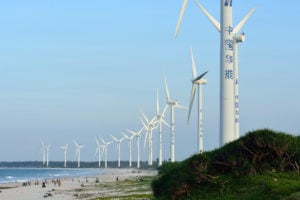The US news media has now determined that the maths is clear: Joe Biden will be the next president of the United States. The electoral process does not declare an official winner of a presidential election until January, and we are likely to see some recounts and court battles before then, but neither of these tend to affect outcomes.
Biden has already declared that one of the first things he will do after his inauguration on 20 January is to begin the process of rejoining the Paris Agreement. Since the agreement was written explicitly not to require US Senate concurrence, the process should be relatively simple. It certainly does reflect the president-elect’s intention to address a climate change problem that the majority of Americans now recognise as a real and growing global risk.
Biden ran on the most ambitious climate programme proposed by a party nominee in US history. He brought into his process those like Representative Alexandria Ocasio-Cortez, who have made fundamentally rethinking the US economy to respond to the magnitude of climate risk the centrepiece of their efforts. He put out ambitious plans both for a strong domestic programme and for renewed global leadership, with a national goal of net zero emissions by 2050. He has also highlighted the importance of climate action in his major speeches, including his victory speech.
Biden’s attention to climate change, the greater pressure – especially from his younger supporters – for climate action, and the legacy of President Obama’s important agreement with China on climate change, have all raised the question of whether there will be renewed US–China cooperation on this critical challenge for our planet. Cooperation was not easy to establish in the Obama administration. Both countries misread signals and got off to a very rocky start at the Copenhagen negotiations in 2009. The agreements they ultimately made in 2014 and 2015 led to the Paris Agreement, but once again, a great deal has transpired since then that will create even more challenges.
Biden must rebuild US leadership
The US clearly must re-establish itself as a trustworthy partner. Biden’s announcement of his intentions immediately after his victory is a good start, but the US’s climate partners have all been left with unmet commitments twice before. After all, the US first pulled out of the Kyoto Protocol it negotiated in 2002, and then left the Paris Agreement under President Trump. Because of the relative ease of rejoining Paris and the short timespan that will have elapsed between when the US officially left Paris on 4 November this year and Biden’s January inauguration, resumption is one of the president-elect’s easier tasks. But he has said he wants to resume leadership on climate, not just act as a signatory to an agreement.
Leadership will require real commitments from the United States, commitments that were encompassed by Biden’s ambitious proposals, but are now in doubt as he looks to have real challenges in Congress. To enact his US$2 trillion Build Back Better plan, which would truly transform the US into a green economy, Biden will need Congress to pass legislation and appropriate funds. While his party, the Democrats, controls the House of Representatives, it is unclear whether they will have the votes they need in the Senate. There are still two seats to be determined on 5 January in Georgia. If the Democrats win them, which is far from certain, the two parties would be tied, and Vice President-elect Kamala Harris would then have the deciding vote. That would leave a razor thin margin, given that some Democrats, like Senator Joe Manchin of coal-producing West Virginia, are somewhat protective of fossil fuel interests. But that is only a best-case scenario. It is at least as likely that Biden will face an opposition majority in the Senate.
That doesn’t mean the new president will be without tools to enact some climate policy, but dramatic change will be a challenge. Firstly, he will be able to appoint officials who are dedicated to climate action. This will include his negotiators at the State Department, the leadership of the main regulator, the Environmental Protection Agency, and the leadership of the Department of Energy. We can expect work ranging from constructive efforts in international negotiations to a shift to funding clean energy research and development. Most importantly, Biden should be able to revive the regulatory efforts President Obama initiated, from regulating power plants under the Clean Air Act, to regulating vehicles through efficiency standards, all of which were rolled back under Trump.
The Trump administration actively opposed California’s requirements for clean vehicles. We can expect that policy to be reversed and President-elect Biden to actively support and encourage state and local governments to develop effective climate plans. Given that US–China cooperation during the past four years has been most robust at the subnational level, especially the cooperation between China and California, Angel Hsu and I have suggested this may be one of the most fruitful avenues for rebuilding the relationship.
While it is hard to imagine the full Build Back Better plan being enacted without a Democratic Senate, it is possible that pieces of it will succeed under both post-Covid recovery plans and infrastructure development plans. Just as the Obama administration used the 2009 Recovery Act to support renewable and energy efficiency projects, the Biden administration is likely to try the same as it attempts to recharge the economy after the recession induced by Covid-19. Many expect that a robust infrastructure bill will be one of Biden’s first initiatives, and there is at least a great deal of hope that he can achieve congressional support for a bill that starts the work of rebuilding the US in a more climate-friendly manner.
Working with China
Thus, the Biden administration may have a climate plan, put together somewhat piecemeal, to bring to the international table. At the same time, the climate challenge itself has become more urgent, and other countries have not been standing still. China has pledged to become carbon neutral by 2060, and while that is a new goal, China has made progress in energy efficiency, renewable energy, nuclear energy and establishing a carbon market in the last several years. Both countries now have these long-term goals, which helps to align their approaches, and now the pressure will be to establish clear intermediate targets and milestones.
Whether the two countries, responsible for 40% of global emissions, can work together will depend not just on their ability to enhance their domestic programmes, but also their ability to cooperate. The bilateral relationship has deteriorated considerably under Trump. In retrospect, it seems clear that tensions were already rising under Obama, and that many Americans felt that the Chinese government had not been sufficiently responsive to US concerns. While many feel Trump’s reliance on trade wars was not effective, differences on a range of issues from security to trade to human rights continue. The challenge will be whether the US and China can find a way to work together in an environment of increased competition and complexity.
The right model for a new view of the climate relationship might be to look at approaches like that which created the World Trade Organisation, rather than a more general idea of cooperation. A trade agreement sets the parameters for vigorous competition by all trading countries. The key for governments is to establish the liberal institutional order, the rules of the game, under which countries compete. As the US and China increasingly view each other as chief competitors, agreements, including Paris, might be best viewed in this light. The object is to establish the parameters for decarbonisation. Then countries and companies will compete to produce the best products, methods and policies for reducing carbon pollution. The result of competition within a set of rules and standards could be to produce new and better approaches to decarbonisation at lower cost. In any event, a realistic model will need to recognise that the US and China will often be competitors, but nevertheless share a profound interest in reducing the harm from global warming.









